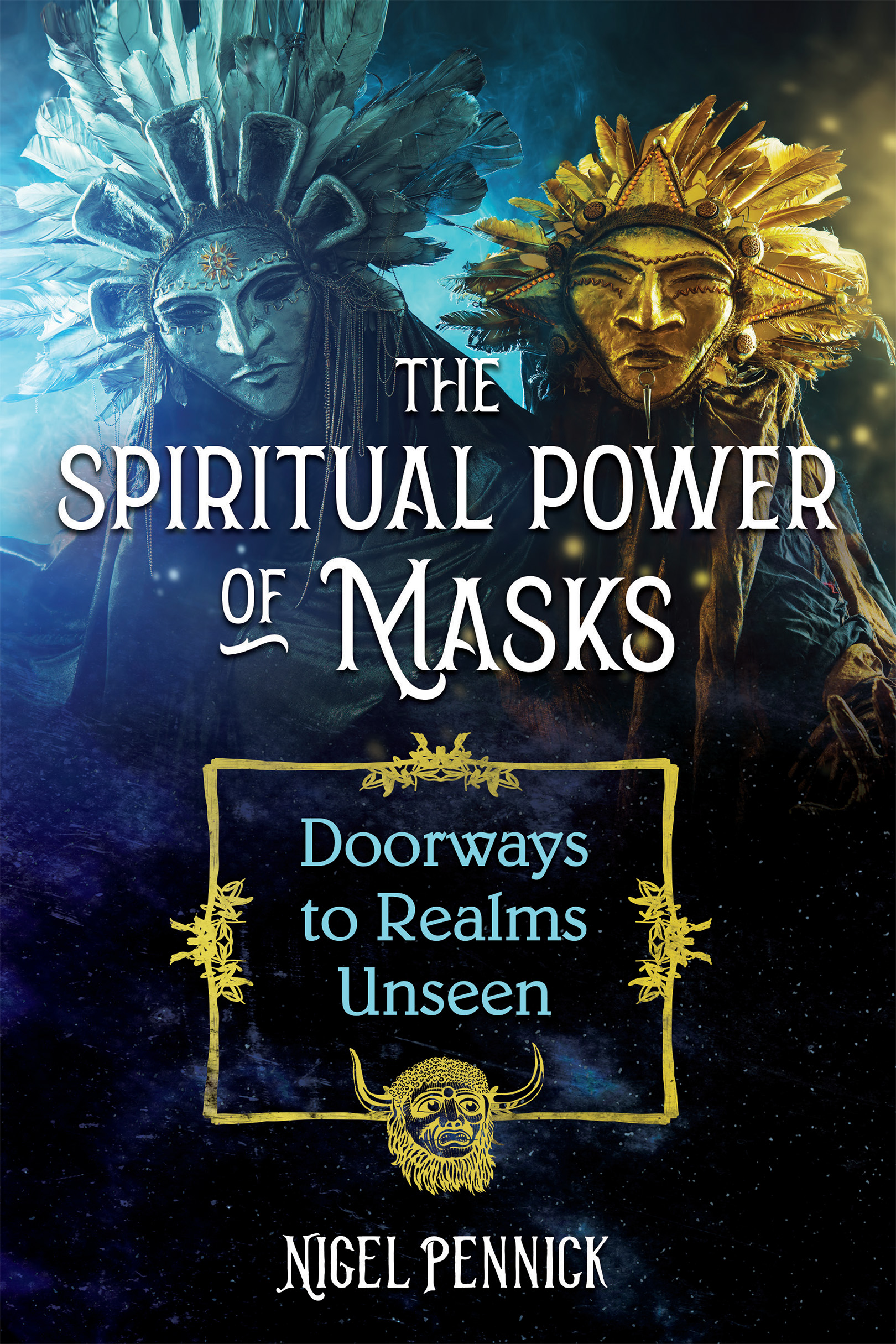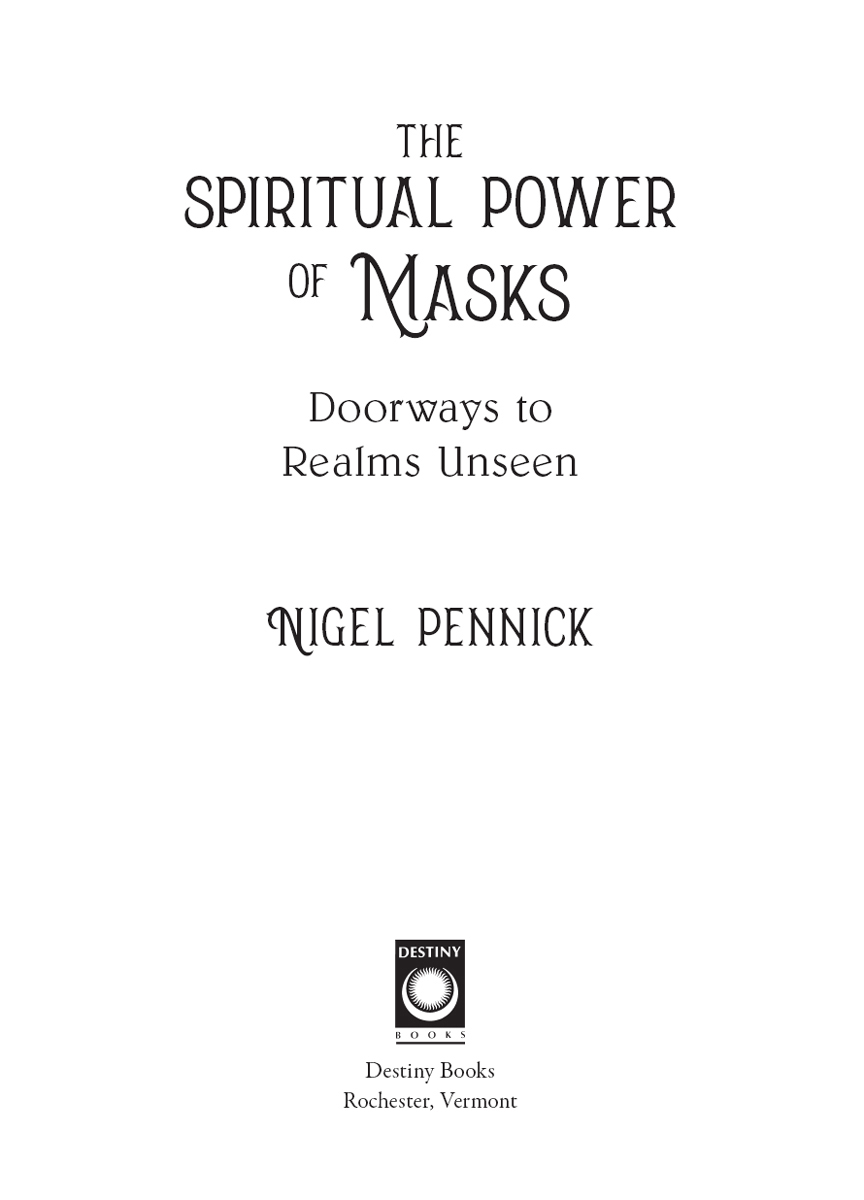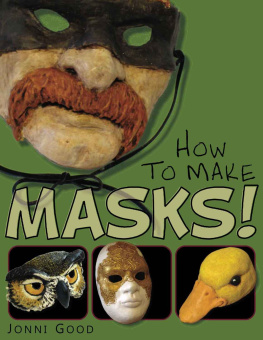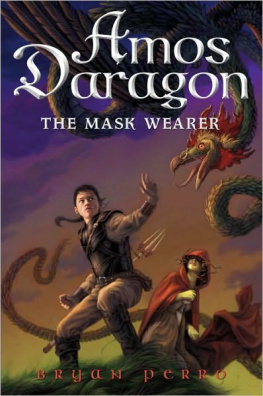

THE SPIRITUAL POWER OF MASKS

This book is a gem! As always, Nigel Pennick explores his intriguing subject with ferocious intensity, beautifully balancing his lenses from telescopic to macroscopic. He writes with a density of detail and archival attention, galloping through centuries in single sentences, crisscrossing countries and even continents in single bounds. His prodigious knowledge, gathered and retained over a lifetime, pours fortha cornucopia of richnessand sometimes may seem like simple lists but which transcend as categorical abundance of evidence that lead up to his anecdotal expansions. Well done, Mr. Pennick!
LINDA KELSEY-JONES, PRESIDENT OF SAN MARCOS AREA ARTS COUNCILAND DIRECTOR/CURATOR OF THE WALKERS GALLERY, SAN MARCOS
Praise for Previous Works by Nigel Pennick
Nigel Pennick is a true initiate who can demonstrate to the reader how nature and cosmos correlate to each other. He explains medieval traditions and Celtic magic in a way that helps us understand how these topics are universal, gives us knowledge about ourselves, and is of highest relevance for humankind today. I regularly return to Nigel Pennicks books.
THOMAS KARLSSON, PH.D.,AUTHOR OF NIGHTSIDE OF THE RUNES
Written by one of the great wisdom keepers of British lore, The Ancestral Power of Amulets, Talismans, and Mascots [contains]... folklore by which people have kept themselves safe against plagues... and evils of many kinds. Very highly recommended as an authentic sourcebook of protective wisdom.
CAITLN MATTHEWS,COAUTHOR OF THE LOST BOOK OF THE GRAIL
Richly researched! Magic in the Landscape is a fascinating insight into a practice in need of returning, one that will go a long way in healing and reclaiming a magical relationship with the sacred landscape.
PHILIP CARR-GOMM,AUTHOR OF DRUID MYSTERIESAND LESSONS IN MAGIC
[Elemental Magic is] one of Nigel Pennicks best! Thorough, practical, and informed by a profound grasp of traditional European lore, this classic book on the art and practice of natural magic belongs on the bookshelf of any working mage.
JOHN MICHAEL GREER,AUTHOR OF THE DRUID MAGIC HANDBOOK AND THE DRUIDRY HANDBOOK
Nigel Pennick is one of the greatest living runic experts, bringing meticulous research and a profound magical understanding to his subject. This important book [Runic Lore and Legend] examines the distinctive Anglo-Saxon Futhark of Northumbria, essentially setting the thirty-three runes in the context of both time and place.
ANNA FRANKLIN,AUTHOR OF PAGAN WAYSTAROT
Well-researched and wonderfully illustrated, Pennicks telling of local history and mythology is written in an accessible, interesting, and enthralling way and kept me engrossed from beginning to end. Witchcraft and Secret Societies of Rural England is very highly recommended!
JUNE KENT,EDITOR OF INDIE SHAMANMAGAZINE
Whether we call it magic or folklore (or even superstition), the traditional, often pre-Christian knowledge described in Pagan Magic of the Northern Tradition is fascinating. Ive been referring to Pennicks books for years when I need a fact or an example of some interesting early magic to cite in my books and blogs. I learned something new on every page!
BARBARA ARDINGER, PH.D.,AUTHOR OF PAGAN EVERY DAY AND SECRET LIVES
Operative Witchcraft is an unromanticized warts and all survey of the real history and lore of witchcraft in the authors native England and elsewhere. One could not ask for a more knowledgeable and sympathetic guide through these shadow-filled realms than Nigel Pennick.
MICHAEL MOYNIHAN,COAUTHOR OF LORDS OF CHAOSAND COEDITOR OF THEJOURNAL TYR: MYTHCULTURETRADITION
Solidly referenced and carefully illustrated, The Book of Primal Signs seems to travel everywhere and touch everything.
RICHARD HEATH,AUTHOR OF SACRED NUMBER AND THE ORIGINS OF CIVILIZATION AND SACRED NUMBER AND THE LORDS OF TIME
Contents

PREFACE
The Meaning and Function of Masks
T his book is about the many variants of disguise that people have created and worn from early times until the present day. Focusing on the European tradition, it describes and discusses the meaning and function of masks, rituals, and ceremonial disguises with detailed historical and contemporary examples, mainly from Britain, where the author has been a participant. The themes dealt with here all interpenetrate one another, from religious and rural ritual to theatrical performance, carnival, and riot. Nothing of it has ever been fixed rigidly; all was and is in continuous flux, and new forms have emerged as conditions changed, while retaining the continuity of their underlying eternal reality. All examples presented here are generic and have occurred over hundreds of years and recur in many places in Europe. There are no borderlines, only transformation.

Fig. P.1. Demon or guiser? Medieval stone carving fragment, Wisbech Cambridgeshire, England (See also color .)

INTRODUCTION
Incarnating the Spirit Depicted by the Mask
T here is a spiritual power in masks, hints of other things that remain unspoken, stylized yet ideal images of ideal qualities, otherworldly substances, ritually activated. For the masks wearer is representing the archetype, whether it be the ancestral or the dead, a divinity or a power, a being of the eldritch world or a character in a formalized play. The boundary line between human guisers, lifeless effigies, ensouled images of deities, and uncanny beings is always fluid and uncertain. The masker is located at the intersection point between the present and the past, the personal and the collective, the living and the dead, this world and the Otherworldfor the mask enacts the dialogue between the container and the contained, the exterior and the interior, the seen and the unseen. The mimesis of masked mumming means that the masker personates the masks character for the duration of the masquerade. The person inside is subordinated to the power signified by the mask. Whatever the being so personated, the performance takes place in the here and now and is operative by its present effects. For these are the masks of anonymity, worn by nameless guisers enacting ritual roles, incarnating the spirit depicted by the mask. In so doing, they partake of something of the eternal, the archetypal, that is present in the transience of keeping up the day. This book does not intend to be a comprehensive listing of every masked and disguised performance that has ever been documented over the centuries in Europe. It is not a literalistic catalogue of here they did this and here they did that, a work of numerical taxonomy, full of percentages and distribution maps that, however interesting, are artifacts of fragmentary historical documentation that often demonstrate little but drive the spirit away from an existence that is preeminently capable of infinite and joyful variation.
Next page









